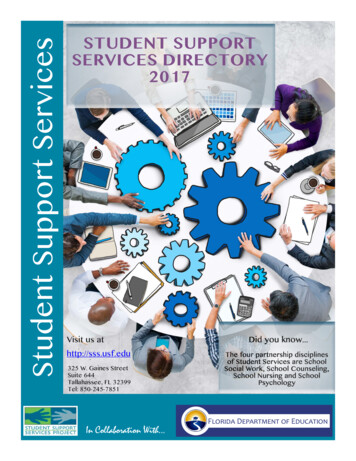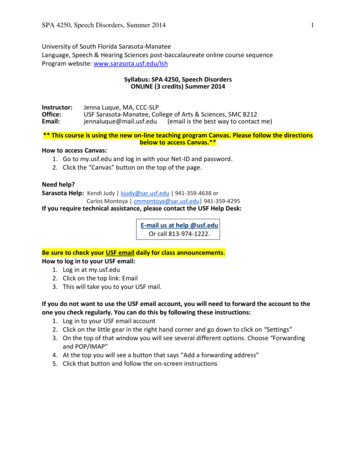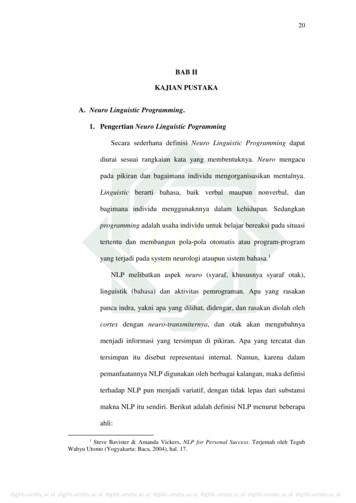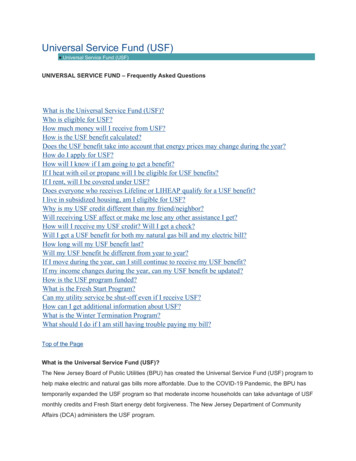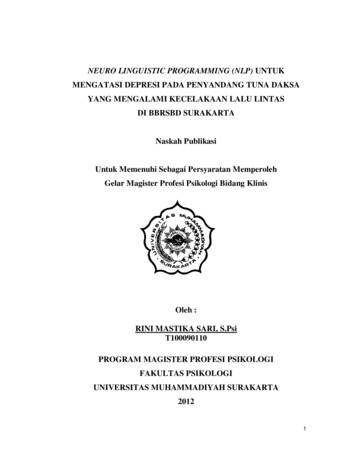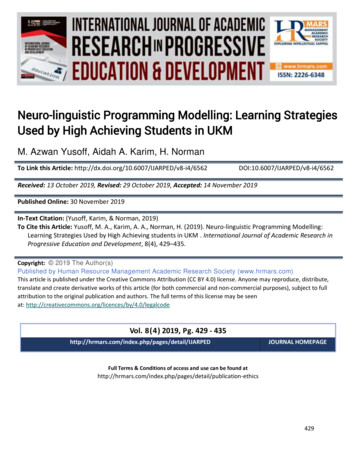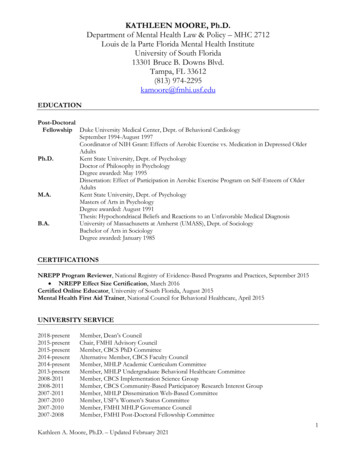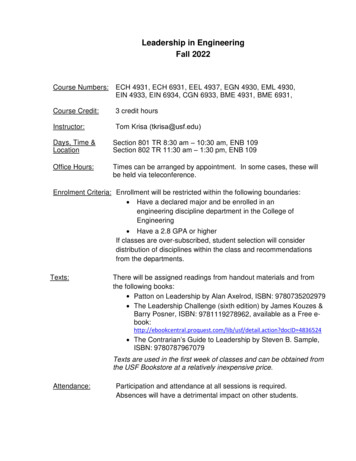
Transcription
Societal Linguistic BackgroundMichael is an outgoing and pleasant seven-year-old from Vietnam. Born on March 24,1997, this first-grader and his family have been in the United States for at least two years. Bothof his parents are employed by Wal-Mart as nail technicians. They speak Vietnamese at theworkplace and in the home, but they are able to communicate with Michael’s teachers in Englishadequately. Since English is quickly growing to be the preferred second language of Vietnam,Michael’s parents may have had some experience speaking English in their home country.Michael’s parents harbor no resentment toward their home country, but wanted to offer Michaelmore opportunities for advancement in America.Upon arrival in America, Michael’s family found housing in a middle-class, Englishspeaking apartment complex. It would be typical to find Michael outside playing with theneighborhood children that also attend the same school.After conducting research about Vietnam, some interesting trends were discovered. Theunemployment rate in Vietnam was recorded as 25% (1995 est.). This seems excessive whencompared to the rates of Americans who are out of work, which was estimated to be 5.8%. Alsonotable was the percentage of people falling below the poverty line. In Vietnam, 37% of citizensare considered to be impoverished. This is significantly higher when contrasted with the 12.7%poverty rate in the United States. For more statistical data on Vietnam, visit the CIA website.These factors may have been instrumental when Michael’s family decided to move to the UnitedStates.Moving to Florida seems interesting when studying the Vietnamese population of thestate. According to the 2002 American Community Study (conducted by the US CensusBureau), 35,437 claim Vietnamese heritage. That composes approximately .2% of thepopulation of Florida. That is less than the total population of Vietnamese living in America—Vietnamese-Americans make up .4% of the population of our nation. For other statisticsconcerning the racial composition of the United States, visit the Census Bureau website.
LINGUISTIC DEVELOPMENTDOA3 months1 ry limitedFrequentlyomitted inspeechMakes syntaxerrors inspeechExperimentingAbility toidentify some but still usingitems in both incorrectlylanguagesImprovement;still makeserrorsErrors are lessWorkingknowledge of frequent butitems in both still occurlanguagesErrors are lessfrequent butstill occurCultural/PragmaticAppropriatenessHesitant tospeak in anunfamiliarenvironmentGainingawareness ofthe appropriateways to expresshimselfAble to speakappropriately ina Does notspeak muchDoes notspeak muchVery limitedVery limitedUnderstandssome ofwhat isbeing saidImproving,but still needscontextualsupportCan writemost of thealphabetlegiblyEasy picturebooksUnderstandsmost ofwhat isbeing saidNeeds onshipsConfuses somevowel sounds,has troublewith consonantblends.
During the short time Michael lived in Vietnam he attended a non-compulsory preschool.From the ages of three to five, he began instruction toward necessary literacy skills he wouldneed to develop. The program offered cognitive, physical, and social stimulation with efforts toprepare students for primary education.The Education for All 2000 Act is a program the government created to insure that allstudents have an equal opportunity to a quality education in primary years. While attendingpreschool, the central focus of Michael’s education was based on the teacher teaching anddirecting the students on what and when to learn content material. Students remained primarilypassive to instruction and only learned what they were taught with out any exploration.Although specifics on the type of literacy education Michael received in preschool areunavailable, it is known that books are distributed to students to take home and study. Parentsare also encouraged to read with their children daily in order to prevent illiteracy.Prior to coming to the United States, Michael was developing his literacy skills at anormal rate. He was speaking in sentences and reading simple books in Vietnamese. Both ofMichael’s parents are bilingual and not only encouraged Michael to speak Vietnamese but theyalso began teaching him some words in English to prepare him for their move to the US.Just before Michael arrived in the US, his home language competence in basicinterpersonal communication skills and cognitive academic learning skills was adequate for theschool environment. He was on grade-level and communicated effectively with his peers andteachers.
WRITING SAMPLE
Transcribed conversation with ESOL student. (M-Michael, T-Teacher)M- My name is Michael.T- How old are you Michael?M- I am 6 years old.T- Six years old.M- I mean seven years old.T- What grade are you in?M- First grade.T- What grade will you be in next year?M- Second grade.T- Are you excited about that?M- Yes.T- Do you know who you want to be your teacher next year?M- No.T- There are some very nice second grade teachers.T- Are you glad school is almost over for this year?M- Yea, I can go to California.T- California. What are you going to do in California?M- I don’t know.M- I am going to stay there for one whole weekT- One whole week, how fun is that?M- I don’t know.T- Can you think of things you might want to do in California?M- Um sleep.T -Can you go swimming in California?M- Yes.T- Who are you going to go to California with?M- My mom and my dad and meT- That will be a lot of fun don’t you think?T- What kinds of books do you like read?M- Green Eggs and HamT- Do you know who wrote Green Eggs and Ham?M -Dr. SeussT- I like Dr. Seuss too.T- Are there any other books you like to read?M- TransformersT- What was that?M -TransformersT- What kind of book is that?M- A transformer book.T- Is it good?M -YesT- What is it about?
M- Transformers.T- Oh. Are they robots in disguise?M -Yea I got two of themT- That is fun.READINGNat the Crab(indicates what the text said)T- Well I have a book here would you help me read it?T- What is the title of it?M- Nat the crab.T- What do you think it is going to be about?M- The crab.T- Can they pinch you?M- YeaM -Nat nat in the crib nat. (Nap, Nat! I the Crib, Nat.)M- What is that?T- He is in a crib, do you see him in the crib right there?M- Yea he look like a babyT- You are rightM- I crab can’t not (A crab can’t nap.)M -I can’t not nap. (A crab can’t nap)M- A crab can tap. (A crab can tap!)M- A crab can nap. (A crab can snap!)M- A crab can slap. (A crab can spin and spin!)M- A crab can nap. (A crab can’t nap.)(A crab naps!)AnalysisAfter being in American schools for over 1 year, Michael has developed a workingknowledge of simple items and words in English. Language errors are much less frequent; hespeaks almost as well as a native speaker the same age. BICS/CALP has improved dramaticallybetween the time of arrival and the time of this study. In recent months, Michael has less of aneed for contextual support to understand teachers and other students.When Michael was asked to read for us, he showed improvement in word recognition andphonemic awareness. He still confuses some vowel sounds (“I” for “A”, for example), and hehas trouble with consonant blends (“sn” and “sp”).
When analyzing the writing sample from Michael, it was apparent that he understood thesounds that letters can make (graphophonic relationships). It appears that he needs practice insight words.Michael is making great strides in learning English. With some help from experiencedand patient teachers, Michael should be on grade level very soon.Problem ScenarioMichael is first grade student who has recently been diagnosed with Attention DeficitDisorder with Hyperactivity. Attention Deficit Hyperactivity Disorder. This “label” has beengiven to him by his teacher who observed him acting out in various ways including playing withobjects during instruction, not remaining seated, and not participating in classroom activities anddiscussions.A clinical definition of Attention Deficit Hyperactivity Disorder states that ADHD isa group of chronic disorders that begin in the childhood years and sometimes lead intoadulthood. Many times individuals diagnosed with this disorder show symptoms of inattention,hyperactivity, and impulsivity. These problems can easily affect every aspect of an individual’sthinking process and daily activitiesAlthough it may appear that there is only one view of Michael’s situation, in actualitythere are various perspectives. The other individuals involved in this situation include hisclassroom teacher, ESOL teacher, school counselor, his parents, and the school principal. Eachof the individuals involved, have their own perspectives and insights to the situation. Thefollowing are the various perspectives of each participant.CLASSROOM TEACHER:Observed hyperactivity traits in Michael’s behavior such as: Playing with objects in and around his desk Not remaining seated Not participating in classroom activities Often out of his deskThe classroom teacher has the idea that he should be placed on medication to help with hishyperactivity.The classroom teacher had a conference with the ESOL teacher and asked her to observeMichael’s behavior while he was in her class.ESOL TEACHER:The ESOL teacher noted the following while working with Michael in his home language: Michel is well behaved and attentive He remains seated through instruction Enjoys participating in activities Contributes to discussions
SCHOOL COUNSELOR:The school counselor met with Michael and developed a plan of action. The counseloradministered a test that has been developed to diagnose ADD. The test is called AttentionDeficit/Hyperactivity Disorder Test. This test is not inclusive, but does show valid results for thefollowing skills: verbal, non verbal, fin/gross motor, memory/intention skills. This data can beuseful in determining the disability or ability level of the student.The results from the test led the counselor to believe that Michael may display behaviors ofADHD in the classroom setting due to the fact he is having difficulty understanding thelanguage. With this information in mind, the counselor also concluded that Michael may be welladjusted in the ESOL classroom because he is in a comfortable learning environment.MICHAEL’S PARENTS:With this information brought to the attention of Michael’s parents they were concerned due tothe fact he displays none of these traits within the home setting. They request that the leastintervention possible be implemented. Along with avoiding all ESE classrooms, the parents alsomade it known that their child would receive equal opportunities for his education or they wouldseek outside legal advice. Michael’s parents also stated that under no circumstances would theirchild be placed on medication.PRINCIPAL:When this matter was brought to the attention of the school principal he stated the following: The school would be willing to work with the parents to insure the success of their child. Michael’s teacher will give him every opportunity within the classroom setting to learnEnglish as his second language. Together, Michael’s classroom teacher, EOSL teacher, school counselor, principal andparents will come to agree on a course of action that will be most beneficial for Michaelto insure his success.MICHAEL’S PERSPECTIVEThe school counselor talks with Michael and receives the following information from him: The other children in class make fun of me because I do not speak English well. I can not do the work in school because it is too hard and I don not understand it. I like my ESOL class because I understand what is going on.Reference:Flick, L.G. (1996). Power parenting for children with ADD/ADHD. San Francisco: Jossey-Bass.QUESTIONS
Reflective/Discussion Questions:Michael’s behavior quickly compelled the teacher to suspect ADHD. Do you think this was anaccurate assumption to make? Why or why not?What do you think was the source of Michael’s behavioral problems? Support your positionwith specific examples.In your opinion, would Michael’s situation be different if his first language was Spanish? Whyor why not?Bloom’s Taxonomy Questions:Knowledge:According to the CIA’s data in Phase 1, what is the poverty level in Vietnam at the time of thiscase study?Comprehension:Explain one reason why Vietnamese citizens may immigrate to the United States.Application:How would you use what you have learned to develop a solution to the problem posed in PhaseIV?Analysis:How is Michael’s language issue related to his behavior in the classroom?Synthesis:Make a prediction of Michael’s future success with the English language given the informationpresented in the case study.Evaluation:As a teacher, what would you do if you had a student similar to Michael? Give examples tosupport your position.
Michael is making great strides in learning English. With some help from experienced and patient teachers, Michael should be on grade level very soon. Problem Scenario Michael is first grade student who has recently been diagnosed with Attention Deficit Disorder with Hyperactivity. Attention Deficit Hyperactivity Disorder. This "label" has been
